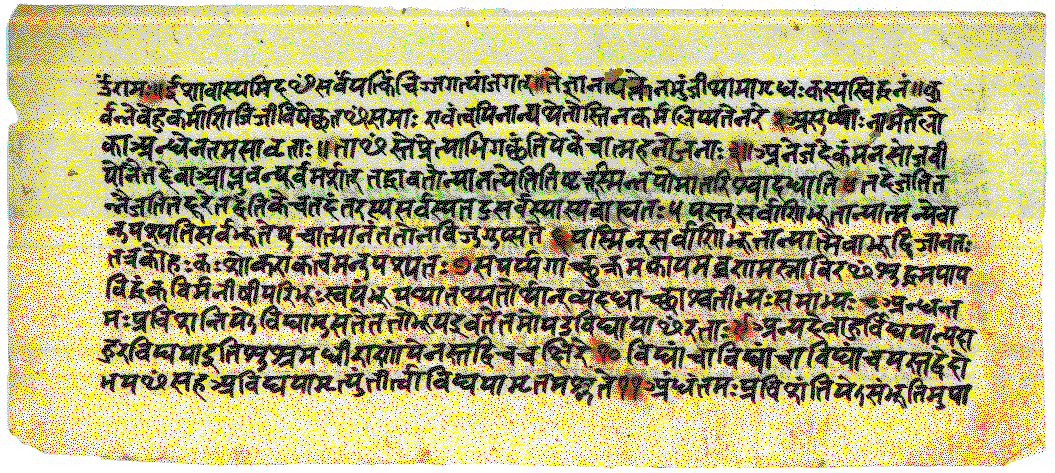KNOWLEDGE THAT FREES US FROM ALL SORROW
In the Indian culture, the Vedas represent a vast body of ancient wisdom texts that prescribe a religious and spiritual way of life. The Vedas denote a body of knowledge through which we come to know about the goals of human life (purushārtha) and means to attain those goals (sādhya-sādhan viṣya). The Sanskrit word “veda” is derived from the root “vid” which means “to know.” Hence, veda means a source of knowledge or means of knowledge. The Vedas are not considered to be human compositions; they are regarded as “apauruṣeya” (authorless, “not a product of human intellect”). The Vedas are believed to be divinely revealed to the ṛṣis (the seers) during a state of deep meditative absorption.
Accordingly, Hindus regard the Vedas as svatah pramāṇa (“self-evident means of knowledge”). The ṛṣis are not the creators or authors of the Vedas; they are called the mantra-drashtās: the ones who had a vision of the mantras or who have heard the mantras because of the purity of their mind. Vedas are also called śrutis (“that which is heard”)— śruyate iti śruti—in contrast to smṛti (that which is remembered).
The great Veda-Vyāsa (literally, the “arranger” or “compiler” of the Vedas) is traditionally credited with classifying this literature into four texts:
- Ṛgveda (the grandest, the oldest Veda; mantras set to poetic meters)
- Yajurveda (mostly prose mantras)
- Sāmaveda (mantras set to music, meant to be sung)
- Atharvaveda (most of the mantras are revealed by Atharva-Angīras ṛṣi)
These four Vedas put together are revered as revelation by all Hindus.
Broadly speaking, Vedas can be divided into two parts: the earlier portion (Veda purvabhāga) deals with the religious (dhārmic) way of life designed to ensure the mutual well-being of both the society and the individual. This way of life leads to the all-round, integral growth of the individual in the physical, emotional, intellectual and spiritual domains, while at the same time ensuring the welfare of the society. Most importantly, such religious way of life becomes a stepping stone to come to the study of the final portions of the Vedas that deal with spirituality. In the Vedic vision, religion and spirituality are elegantly integrated: without religion, one cannot pursue spirituality and without spirituality, religion is incomplete.
The second part, the concluding portion (Veda antabhāga or Vedānta), deals with the spiritual way of life leading to the liberation of the individual. Vedānta (Veda+antā: end of the Veda) comprises several philosophical treatises known as Upaniṣads which are presented in the form of a dialog between the teacher and the student (guru-śiśya samvāda). Perhaps, there is a subtle hint here that the Upaniṣads should only be studied in close proximity of a competent teacher, and not by oneself. Given the profoundness of the subject-matter, a self-study of Upaniṣads may not give the intended results or may even prove counter-productive.
In the Bhagavad Gītā, Śrī Kṛṣna advises all spiritual seekers, through Arjuna, to seek the help of a guide to learn this knowledge in the following manner:
tad viddhi praṇipātena paripraśnena sevayā /
upadekṣyanti te jñānaṃ jñāninas tattvadarśinaḥ // 4.34
Understand the true nature of that Knowledge by approaching an illumined person, inquiring properly with reverence and devotion. The wise seers of Truth will instruct you in that Knowledge.
In the similar vein, Muṇḍaka Upaniṣad 1.2.12 provides the following succinct instructions:
parīkṣya lokān karmacitān brāhmaṇo nirvedamāyānnāstyakṛtaḥ kṛtena /
tadvijñānārthaṁ sa gurumevābhigacchet samitpāṇiḥ śrotriyaṁ brahmaniṣṭham //
After having properly examined the transient nature of all things in the world that are attained through actions, a wise person should acquire a sense of dispassion: That which is not the product of any action cannot be produced by actions—nothing that is eternal can be produced by what is not eternal. In order to understand that Eternal, one should humbly approach a great teacher who is well-versed in the Vedas and always absorbed in Absolute.
The Vedas can be broadly classified into three divisions: karma-kāṇḍa, upāsanā-kāṇḍa, and jñāna-kāṇḍa. The karma-kāṇḍa stresses the performance of fruitive actions; upāsanā-kāṇḍa deals with devotion and meditative practices; and jñāna-kāṇḍa deals with the knowledge of the self (ātam-jñānaṃ). According to one estimate, the karma part of the Vedas contains 80,000 mantrās (verses), the upāsanā part contains 16,000 mantrās and the jnana part contains 4,000 mantrās.
Vedānta consists of several Upaniṣads. Although there are 108 Upaniṣads[1] that are extant, but the following are considered more important because the great commentator, Ādī Śaṅkara, wrote elaborate commentaries on the following:
- Bṛhadāraṇyaka Upaniṣad
- Chāndogya Upaniṣad
- Māṇḍūkya Upaniṣad
- Kena Upaniṣad
- Kaṭha Upaniṣad
- Muṇḍaka Upaniṣad
- Aitareya Upaniṣad
- Taittirīya Upaniṣad
- Praśna Upaniṣad
- Īśa Upaniṣad
- Śvetāśvatara Upaniṣad
WHAT IS THE CONTENT OR ESSENCE OF UPANIṢADS?
As stated earlier, Upaniṣads present their teachings in the form of a teacher-student dialog. To illustrate the nature of their teachings, let’s take one key dialog from one of the most famous Upaniṣads, called Chāndogya Upaniṣad (7.1.1 – 7.1.3).
This dialog takes place between Sanatkumāra and Nārada, both sons of Brahmā, the Creator.
Nārada approached Sanatkumāra and said: “Holy Sire, please teach me.”
Sanatkumar replied: “First let me know what you already know; I will then teach you further.” Nārada was a very learned person. So Santatkumāra first wanted to find out what Nārada already knew so that he can start the teaching from there onwards.
Nārada, who was virtually a walking encyclopedia, replied that he has studied all the Vedas, the Epics and the Purāṇas, mathematics, logic; ethics and politics; astrology and astronomy, physical sciences; music, and performing arts.
“All this is merely name,” declares Sanatkumāra. Saying so, Sanatkumāra has pulled the rug, as it were, from under Nārada’s feet.
Nārada agrees: “Yes, these are only words, really speaking. All this learning has only made me merely a word-knower (mantra-vit) and not yet a Self-knower (ātma-vit). From the likes of you, I have heard, ‘The knowers of Self cross over sorrow” (tarati śokamātmavid). Here I am suffering from sorrow, sir. Please take me across this sea of sorrow” (so’haṁ bhagavaḥ śocāmi taṁ mā bhagavāñchokasya pāraṁ tārayatviti tam: Chāndogya Upaniṣad, 1.7.3)
In essence, Sanatkumāra tells Nārada that he has to know his Self (ātmā); worldly accomplishments, however great and glorious, cannot give peace, security, and happiness because anything that is extraneous to our Self cannot free us from sorrow.
Therefore, the only permanent remedy for worldly sorrow is Self-Knowledge (ātma-jñāna).
Upaniṣads declare that Brahma-vid apnoti param (Tait. 2.1.1), says the Taittiriya Upanishad: “Whoever realizes this Brahman attains the Supreme.”
And this ātmā-vidyā is the subject matter of Upaniṣads.
WHAT IS ĀTMĀ (SELF)?
Upaniṣads tell us that ātmā is of the nature of the consciousness (chaitanya-svarūpa) or of the nature of Knowledge (jñāna-svarūpa). The next question is what is consciousness?
There are four main characteristics of consciousness:
- Consciousness is not a part, property or product of the body. It is an independent entity which pervades the body by virtue of which the body is conscious. Scriptures liken ātmā to light or space (vyōma-vat).
- This consciousness that pervades the body is not limited by the size or the shape of the body. It is formless, limitless principle that pervades and enlivens the body.
- This consciousness which is a limitless, formless, and all-pervading entity is known by two names: ātmā and Brahma. The Upaniṣad tell us that ātmā pervades all over (āpanoti sarvam). Since it pervades all, it is also called Brahma: Brahmnāt, Brahma samastavāt.
- This consciousness does not die when the physical body dies. It is nitya chaitanya (eternal consciousness) and ananta (limitless).
What is the nature of ātmā? Swami Parmārthānanda, a modern Vedāntā teacher, answers this question as follows:
- Ātmā is not a part, property or product of the body.
- Ātmā is a consciousness or “I-principle” that enlivens the body.
- Though inhering the body, it is not limited to/by the body. It is all pervading.
- Being all-pervading, it is called by two names: ātmā and Brahma.
- It is unborn and eternal and does not die with the death of the body.[2]
What is Brahman? The word comes from the Sanskrit verb root brh, meaning “to grow.” Etymologically, the term means “that which grows” (brhati). In the Taittariya Upanishad 2.1, Brahman is described as satyam jnanam anantam brahma: Brahman is of the nature of truth, knowledge and infinity. It is often described as Sat-cit-ānanda (being-consciousness-bliss). Its greatest symbol is Ōṁ: the unstruck, primordial sound, the hum of the universe. It is the All, the Absolute, the Totality of all and everything.
The Upaniṣads deal with one and only one subject: the absolute identity of the individual self with the universal Self (ātma-brahma-aikyam). According to Vedāntā philosophy, spiritual liberation is not possible without realizing this identity (aikyam) between the ātmā and the Brahma: brahmātmaikya bodhena mokśaḥ sidhyati nānyathā, says Śrī Śaṅkarācārya in Vivekachudamani (56).
LIBERATION IN VEDĀNTA
In Vedānta, liberation means realizing Brahman as our own true self (ātmā): Aham Brahma asmi. Only those who know their self (as the limitless Reality) transcend worldly sorrow (tarati śokam ātamvit: Chāndogya Upaniṣad, 7.1.3).
Liberation means knowing “Who Am I,” really. Vedanta says, You are That: Sharīra-taryam vyatirikta, avasthā-traya-sākshi, panca-kosha-vilakshana-Satchitānanda svarupa Aham Brahma Asmi: Different from the physical, subtle, causal bodies; witness consciousness of the three states of waking, dreaming, and deep sleep; and different from the 5 sheaths: physical-self sheath, vital air sheath, mental sheath, intellect sheath, and bliss sheath—different from all this, I am Brahman—the Limitless, Infinite Consciousness Absolute.
One famous śloka of Bhagavad Gītā succinctly explains the nature of our real Self as follows:
न जायते म्रियते वा कदाचिन् नायं भूत्वा भविता वा न भूयः /
अजो नित्यः शाश्वतोयं पुराणो न हन्यते हन्यमाने शरीरे // २.२०
na jāyate mriyate vā kadācin nāyaṃ bhūtvā bhavitā vā na bhūyaḥ /
ajo nityaḥ śāśvatoyaṃ purāṇo na hanyate hanyamāne śarīre // 2.20
The Self is never born nor dies, nor is it that having come to exist, It will again cease to be. This One is birthless, eternal, everlasting, and primeval; It is not killed when the body is killed.
Earlier, Arjuna has been told: नासतो विद्यते भावो नाभावो विद्यते सतः 2.16
nāsato vidyate bhāvo nābhāvo vidyate sataḥ:
The unreal never is; the Real never ceases to be.
Realizing this, what could be the cause of sorrow?
Hence the Upaniṣads declare categorically:
The knowers of Self cross over sorrow (tarati śokamātmavid).
——————————————————-
[1] Once a seeker, so the story goes, approached a mahātmā (“a great soul”) and asked: Revered Sir, how many Upaniṣads do I have to study to know myself?” The mahātamā replied with a question: “How many mirrors do you need to look at yourself?!”~Narrated by Pujay Swami Tejomayananda ji, Brahm-Sutras Discourses, Discourse no. 1.
[2] Swami Paramārthananda, The Essence of Vedanta-Part 1. General Talks.


Recent Comments